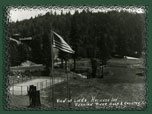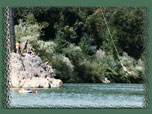
The History of Hacienda
The 30's in Hacienda
As expressed on the home page the development and golf course were established in the late 20's with the best natural swimming hole on the Russian River. At that time, the only way to get to the river was by train, with ferry connections to San Francisco. When the railroad floundered in 1935, the Hacienda Del Rio Golf Resort followed suit.
The 40's
Twelve years later, the conversion of the old railroad right of way to a county road was completed with the widening of the Hacienda Bridge. Thus, the way was paved -- literally -- for Hacienda's golden age.
The 50's and 60's
The 1950's and 1960's were a time of a rising middle class. Relatively few women had jobs outside the home. These factors created a fabulous opportunity for young families: Mom and the kids could spend all summer at the river. Dad, the breadwinner, would commute into the City on Monday morning, bach it at home through Thursday night, and drive back to the river on Friday after work.
Families would spend every afternoon on the beach. Friendships were founded and renewed every year. Some have lasted a lifetime.
The end of the 60's to the 70's
By the end of the 60's, to say that things were changing would be an understatement. Women were moving into the workforce. Summer long vacations were becoming less & less practical. Recreational and travel opportunities were multiplying, as inexpensive air fares opened up the whole world to middle class vacationers. Plus the time, effort, and expense of maintaining cabins in the Hacienda area, now pushing 40 years old, were making the river life less attractive.
The 70's to the 80's
During the 70's and 80's, property values in Sonoma were increasing sharply. The County was transitioning from a bedroom community of the Bay Area to a region with its own economy. More people were commuting from home to work within Sonoma County instead of driving South. As more jobs became available, especially in Santa Rosa, and as the cost of housing soared, the old cabins along the Russian River became the largest stock of low income housing in the County. Many cabins in Hacienda, never intended to be year round dwelling, were bought or rented by families ill prepared financially to shoulder the maintenance of 50 year old cabins. Hacienda was becoming dowdy!
The 90's
In the 90's Sonoma County's affluence began to spread West along the River. As the County began to increasingly look like the new center of the wine world, with Healdsburg as its capitol, the middle class began to return to Hacienda, this time as year around residents. Fewer real bargains could be found. Still buyers were arriving with excess cash to spend on maintenance and remodeling.
Now
Hacienda is now a patchwork of full time homes and summer cabins.
Through it all, a nucleus of original family owners remains. The second generation -- those lucky kids who spent all summer on the beach, are now in their 50's and 60's and third and fourth generationsand even fifth and sixth of some families are here.
To these families, all of the changes -- the dowdiness of the 70's and 80's, the arrival of affluence in the 90's, the present day patchwork -- none of it matters. We know the treasure we have in Hacienda.
This captures it beautifully
I also like the silence of Russian River Valley nights. I have lain in bed, alone in the darkness, in cabins deep in the woods and heard only the low, erotic cello-moan of tree limbs rubbing against each other, punctuated by the occasional eerie hoot of an owl hunting in the night forest. One falls into a long, untroubled sleep in such silence. The next morning finds beyond the window a fog-shrouded wood, dripping with water. Only if you perk up your ears can you hear the distant, muffled sound of cars driven by Russian River Valley commuters on their way to work.
~Steve Heimoff
Wine Journey Along the Russian River



